This Trafalgar Primary History Resource is about The Battle of Trafalgar, the most significant naval battle of the Napoleonic wars. It took place in 1805 just off the coast of Cape Trafalgar in Spain between the English navy and the combined Spanish and French navies.
Trafalgar Primary History Resource -Napoleonic Wars.
 The Napoleonic wars were a series of battles between France and the rest of Europe and by 1805 Napoleon Bonaparte controlled much of the European continent.
The Napoleonic wars were a series of battles between France and the rest of Europe and by 1805 Napoleon Bonaparte controlled much of the European continent.
By the time of this Trafalgar Primary History Resource, Britain stood virtually alone against France.
However, even though Napoleon controlled the European continent, Britain still controlled the oceans. Her navy had managed to keep most of the French navy blockaded in their ports.
Trafalgar Primary History Resource – Vice Admiral Horatio Nelson.
 Vice Admiral Horatio Nelson is one of Britain’s greatest national heroes and his statue stands proudly in Trafalgar Square in London.
Vice Admiral Horatio Nelson is one of Britain’s greatest national heroes and his statue stands proudly in Trafalgar Square in London.
His heroics in battle came at a cost though, he lost his right eye during a skirmish at Calvi and his right arm during an attempt to capture a treasure ship at Tenerife.
Trafalgar Primary History Resource – The lead up to the Battle.
The Battle of Trafalgar was the culmination of many naval battles between France and Britain. In 1802, the Treaty of Amiens was signed, it’s aim was to secure peace between Britain and France.
Unfortunately, during this peace, Napoleon continued to develop his plans to invade Britain, this was because the British navy was blocking his ports, thereby threatening France’s overseas trade.
The treaty failed and when it did Napoleon ordered a fleet of invasion barges to be built and moved much of his army to the Pas de Calais region.
Unfortunately, there was one catch, to invade he had to get his army across the English Channel, this was controlled by the British Navy. Furthermore, the British fleet were blockading the French fleet in their ports at Toulon and Brest.
Trafalgar Primary History Resource – The Chase to the Caribbean.
In March 1805 the French broke out and set sail for the West Indies. Once there, Admiral Villeneuve believed that Nelson’s fleet was larger than it actually was, so he decided to sail back for Europe.
On the way back, Villeneuve’s fleet ran into a flotilla of 15 British ships. After an unconvincing skirmish, Villeneuve struggled back to Cadiz where he joined the Spanish fleet.
Trafalgar Primary History Resource – The Battle Itself.
It was at this point that Lord Nelson came up with a strategy that was so successful that it was used by all navies until the end of the age of sail.
When the battle started Nelson’s plan worked perfectly. The British fleet cut the combined fleet in half and left many French and Spanish ships unable to join the battle.
The British eventually prevailed, aided greatly by the brilliance of his new strategy.
However, both sides suffered huge losses. Despite losing only one ship, Britain lost 449 men killed, with another 1,241 injured. The combined French and Spanish fleet lost over 4,000 men killed with another 2,545 wounded, also 27 ships, sunk or captured.
Trafalgar Primary History Resource – Consequences of the Battle.
For Britain, Trafalgar signified the end of the threat of French invasion and gave her global naval supremacy for the next 135 years.
However, the victory was tinged with sadness at the loss of Nelson. He was commemorated with a statue in Trafalgar Square, that still stands to this day.
To learn more about the effects of Nelson’s victory click on https://www.napoleon.org/en/history-of-the-two-empires/articles/the-true-significance-of-trafalgar/
Trafalgar Primary History Resource – the musical – Trafalgar – Nelson’s Finest Hour
 On the History portal we have a 50 minute musical Trafalgar – Nelson’s Finest Hour which tells the story and the build up to this famous battle.
On the History portal we have a 50 minute musical Trafalgar – Nelson’s Finest Hour which tells the story and the build up to this famous battle.
The script is written so that no actor has to give a speech of more than 5 lines unless it is to be read. Furthermore, it comes with 12 songs that take the story along, and one of them explains Nelson’s brilliant strategy.
To start rehearsing the show immediately simply click on https://www.history-portal.com/product/trafalgar/
